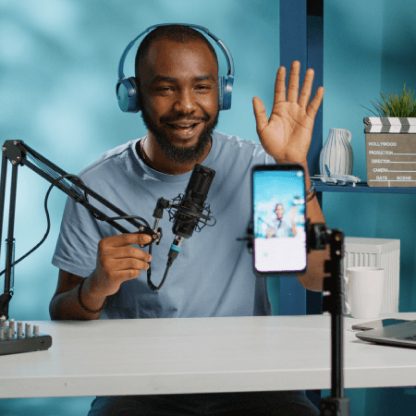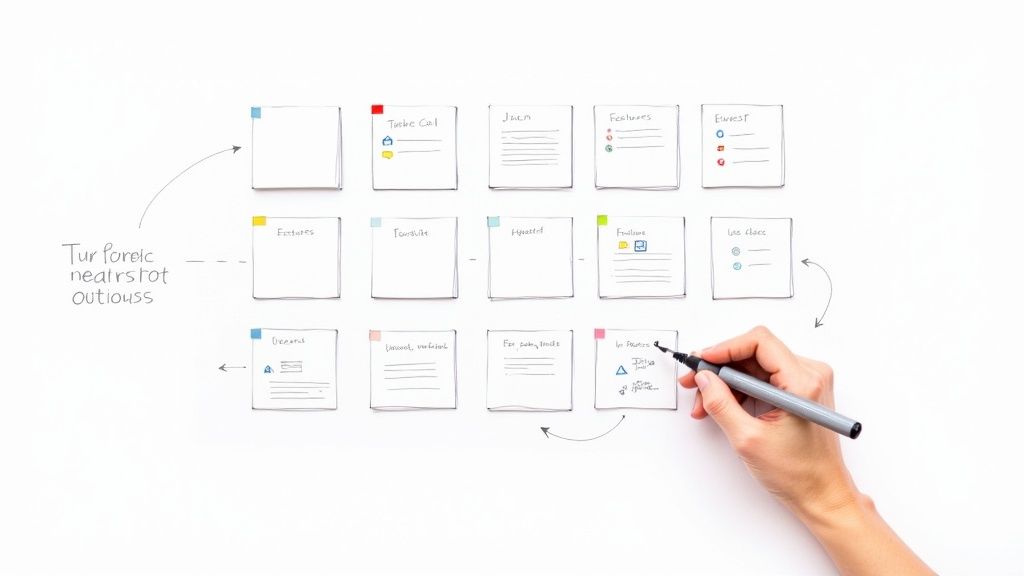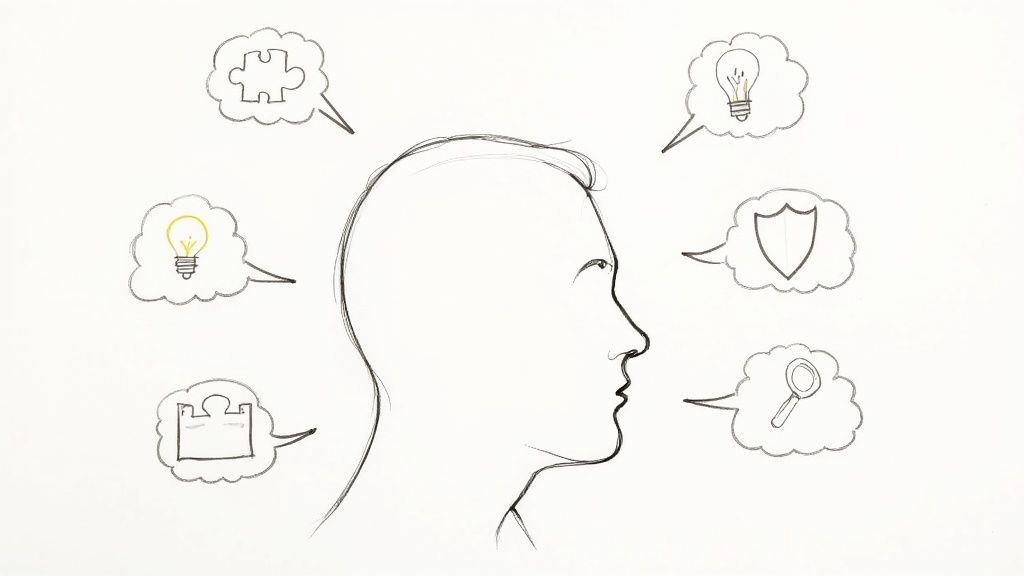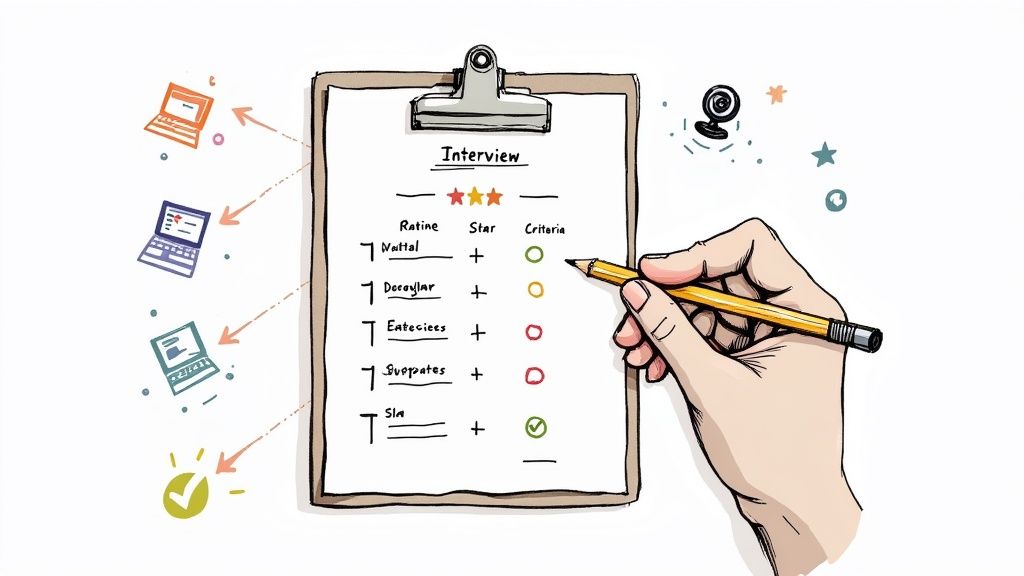To really nail a video interview, you need to think about three things: your tech setup, how your personal story fits the company, and getting comfortable on camera. It’s a simple framework, but mastering these pillars is non-negotiable. Video interviews aren't a quirky trend anymore; they're a standard step in how great companies hire.
Why Mastering Video Interviews Is Non-Negotiable
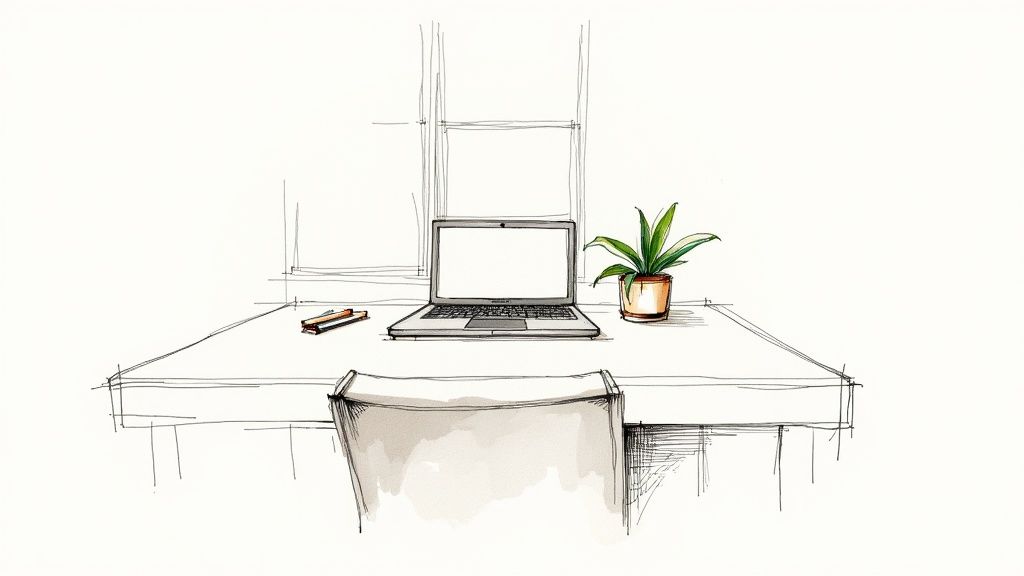
Let's get one thing straight: the video interview is here to stay. If you’ve received an invitation for one, give yourself a pat on the back. You've already beaten out a huge chunk of the competition and proven you're more than just another resume in the pile. This is your moment to show them you’re the right person for the job.
The stakes are higher than you might realize. Around 60% of recruiters now lean on video technology, which means your digital first impression is everything. With the average job opening pulling in about 118 applicants and only 20% of them making it to the interview stage, every single detail counts. You can explore more job interview insights to see just how competitive the landscape is.
First impressions are made in a matter of seconds. Before you even answer a question, your on-camera presence is communicating your professionalism, preparedness, and attention to detail.
Before we dive into the nitty-gritty of your setup and answers, here's a quick checklist to frame your preparation. Think of these as the foundational pillars of your success.
Your Video Interview Success Checklist
| Pillar | Key Action | Why It Matters |
|---|---|---|
| Presentation | Dress professionally and mind your body language. | It creates an immediate impression of your seriousness and confidence. |
| Environment | Find a quiet, well-lit space with a clean background. | Minimizes distractions for both you and the interviewer, showing respect for their time. |
| Technology | Test your camera, microphone, and internet connection beforehand. | Prevents technical glitches that can derail your focus and project unpreparedness. |
| Content | Prepare answers, research the company, and have questions ready. | Shows genuine interest and proves you have the skills and foresight for the role. |
Getting these elements right sets the stage, allowing your skills and personality to truly shine.
Dress for the Role You Want
Your clothing is the first thing an interviewer sees, and it sets the tone instantly. It’s a classic mistake to treat a virtual interview more casually than you would an in-person one. Don't fall into that trap. A surprising 25% of recruiters admit they would dismiss a candidate based on inappropriate attire alone.
Here's how to get it right:
- Do a little recon on the company culture. A tech startup’s vibe is likely different from a corporate law firm's. When you're unsure, it’s always better to be slightly overdressed than too casual.
- Stick with solid colors. Busy patterns, pinstripes, or overly bright colors can create a weird, distracting moiré effect on camera. Go for classic, solid-colored tops that contrast nicely with your background.
- Don't forget the bottom half! Yes, really. Wear professional pants or a skirt. You never know when you might need to stand up unexpectedly, and it's better to be safe than sorry.
Project Confidence Through Body Language
What you don't say can be just as powerful as what you do. Your non-verbal cues are magnified on screen.
Sit up straight, lean in slightly to show engagement, and make a conscious effort to look directly into the camera lens—not at your own face on the screen. This simulates direct eye contact and builds a connection. Using small, natural hand gestures to emphasize your points can also make you appear more dynamic and confident. It’s these little things that help you build rapport, even when you’re miles apart.
Creating a Professional and Fail-Proof Setup
Your answers can be spot-on, but technical glitches or a chaotic background can completely tank your credibility with a recruiter. A fail-proof setup is about more than just having decent Wi-Fi; it’s about taking control of every variable you can to create a smooth, professional impression.
Get started by testing your platform—whether it's Zoom, Google Meet, or a dedicated system like HireVue—at least a day ahead of time. Don't just open the app and call it good. Do a full dry run. Record a quick video of yourself to check your audio for clarity and your video for lighting and framing.
This simple check helps you catch and fix common tech issues before they become a real headache on interview day.

This little process flow breaks down the essential pre-interview tech checks that take you from just being prepared to being truly ready to shine.
Staging Your Interview Space
Think of your background as part of your professional attire. Pick a spot that’s clean, organized, and free from distracting personal clutter. A neutral wall, a tidy bookshelf, or even a simple, professional virtual background are all solid choices.
Lighting is just as important. Always make sure your main light source is in front of you, never behind. You don't need fancy equipment; simply facing a window or using a desk lamp can light up your face and keep you from looking like a shadowy figure. It’s a small tweak that makes a world of difference.
A stable connection is absolutely non-negotiable. I've seen too many great candidates get dropped because of a shoddy connection. Don't let that be you.
Of course, even with a perfect setup, glitches happen. Get familiar with how to troubleshoot common video or audio issues so you can handle any hiccups with grace. It shows you can think on your feet.
Lastly, make a plan to avoid interruptions. Give your family or roommates a heads-up about your interview time, put pets in another room, and silence every single notification on your computer and phone. A simple "do not disturb" sign on your door is an old-school trick that still works wonders.
Telling Your Story to Align with Company Needs
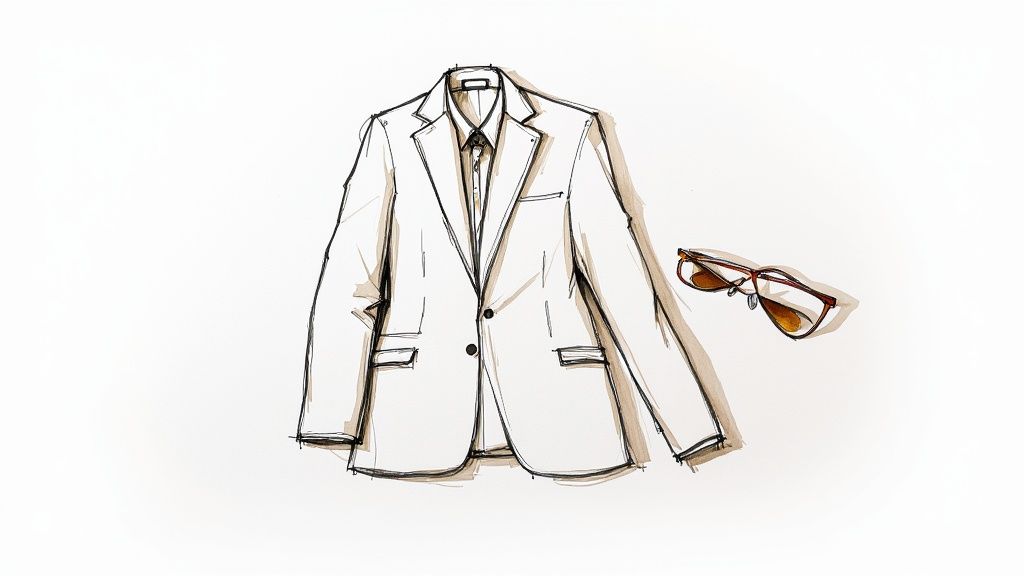
A great interview is never about just rattling off the bullet points from your resume. Think of it more like a conversation where you prove you’re the perfect solution to a problem the company is facing right now. This means you need to go deeper than a quick scan of their "About Us" page. You need to really get into their world.
First thing's first: do some digging on the company’s recent activity. What have they been celebrating over the last six months? Hunt down their press releases, blog articles, and LinkedIn posts. Look for news about new product launches, big client wins, or market expansions. Understanding what they’re excited about gives you a direct line into their current priorities.
With that context, turn your attention back to the job description. It’s not just a laundry list of tasks; it’s their wish list for the ideal candidate. I always recommend printing it out and grabbing a highlighter. Mark up every key skill and qualification they mention more than once. Those are your non-negotiables.
Connecting Your Skills to Their Needs
Once you know what matters most to them, you can start connecting your own accomplishments to their needs. The idea isn't to create a rigid script you'll memorize, but to have compelling talking points ready to go. The STAR method is a fantastic framework for this.
- Situation: Briefly set the scene of a specific challenge or project you faced.
- Task: What was your specific role or responsibility in that situation?
- Action: Detail the concrete steps you personally took to handle the task.
- Result: End with the quantifiable outcome. What impact did your actions have?
For instance, if the job description screams for "strong project management skills," don't just state that you have them. Craft a story around it. "In my previous role (Situation), we were falling behind on a critical product launch. My job (Task) was to get the project back on the rails. I introduced a new agile workflow and ran daily stand-ups to improve communication (Action). As a result, we launched on schedule and came in 15% under budget (Result)."
One of the biggest and most avoidable mistakes you can make is showing up unprepared. It tells the interviewer you don't really care about the role or their time.
Skipping this homework has serious consequences. In fact, preparation mistakes are a huge deal, with 70% of hiring managers saying that unprepared candidates are a frequent problem. This usually boils down to a lack of solid research and the inability to clearly explain why they're the right fit. You can read more about essential job interview statistics at Apollotechnical.com.
Ultimately, putting in this effort ahead of time is what lets you relax and have a real conversation—one that proves you belong there.
Practicing for On-Camera Confidence
Knowing your stuff is half the battle. The other half? Delivering your answers with genuine confidence when you're staring into a camera lens. How you prepare for a video interview has a direct line to how confident you feel, so think of practice as your secret weapon.
Honestly, the best way to get ready is to run a full dress rehearsal. Set up your space exactly as you will for the real thing—lighting, background, everything—and record yourself answering a few common questions. This isn't about memorizing a script. It's about getting comfortable with the medium itself.
Analyze Your Performance
Once you have a recording, it's time to be your own coach. Don't just watch it back; really critique what you see.
Look for these key areas:
- Eye Contact: Are you looking directly at the camera lens? It's so tempting to watch yourself on the screen, but looking at the lens creates a real sense of connection with the person on the other side.
- Pacing and Filler Words: Do you start talking a mile a minute when you get nervous? Are words like "um," "ah," or "like" creeping in more than you realize? Just becoming aware of these habits is the first major step to fixing them.
- Body Language: Check your posture. Leaning in just a bit can show you're engaged and interested. Using natural hand gestures can bring some energy to your delivery, but try to avoid nervous fidgeting or swiveling in your chair.
To really hone your delivery, you can explore some proven job interview practice methods that go deeper into refining your responses and on-camera presence.
The goal here isn't to create a perfect, robotic performance. It's to get so comfortable with the format that your authentic personality and expertise can shine through without being held back by nerves.
I know this process feels incredibly awkward at first, but it is hands-down the best way to spot and fix little issues before they actually matter. Practice builds muscle memory, which is a lifesaver for taming interview anxiety when the pressure is on.
For even more advice, check out our guide packed with additional virtual interview tips to help you feel completely prepared. At the end of the day, confidence comes from preparation.
Showing Up and Following Through
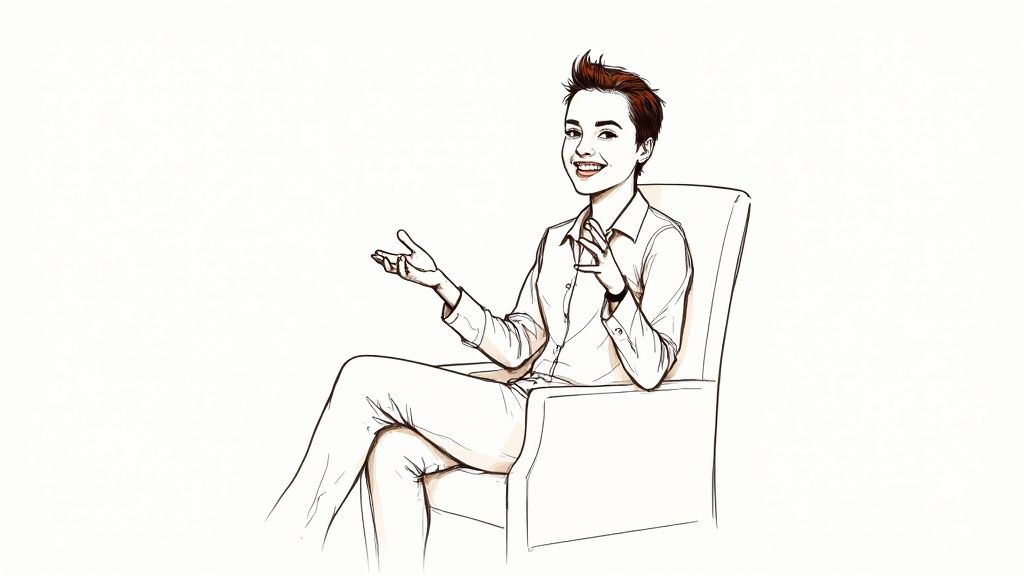
The day is here. All your preparation leads to this moment. Before you even think about clicking that "Join" button, give yourself a small pre-interview ritual to get centered and calm your nerves.
I always recommend logging in about 10 minutes early. This isn’t about being overeager; it’s a smart buffer that lets you do a final, unhurried check of your tech—audio, video, background, the works. The last thing you want is a frantic scramble right before you start recording.
Once you begin, shift your entire mindset from performing to connecting. Listen to the questions with genuine intent, don't just wait for your turn to talk. I find it helps to jot down a key phrase from the question—it keeps you focused and makes your answers more direct.
And when you're answering, don't forget to ask your own insightful questions. This shows you've done your homework and are already thinking like a member of the team. For a deeper dive, our guide on mastering your on-demand video interview has even more pro-level strategies.
The Follow-Up: Your Final Ace in the Hole
Just because you've submitted your last answer doesn't mean you're done. The follow-up is a hugely underrated step where you can really cement the great impression you just made. A generic "Thanks for your time" email is fine, but a truly personalized note? That’s how you stand out.
Sending a personalized thank-you note is more than just good manners; it's a strategic move that reinforces your value and professionalism, setting you apart from other candidates.
The stats are pretty staggering: a whopping 57% of candidates don't bother sending a thank-you note at all. Yet, 80% of hiring managers say that receiving one positively influences their decision-making. Your follow-up is a critical piece of the puzzle. If you're not sure where to start, you can learn everything about writing a compelling follow-up email with this ultimate guide.
Be specific. Mention something you enjoyed discussing, connect one of their challenges to your specific skills, and reaffirm your enthusiasm. It’s a simple action that proves you were paying attention and are genuinely invested in the opportunity.
Answering Your Top Video Interview Questions
Even the most prepared candidates can get thrown by a tricky question or an unexpected situation. It happens. Let's walk through some of the most common hurdles you might face so you can feel completely confident when you hit "record."
Think of this as your personal FAQ for handling the nuances of a video interview.
Right off the bat, you need to know what kind of interview you’re walking into. Is it a live, two-way conversation with a real person, or a one-way recording where you answer preset questions? They require different mindsets. Live interviews are all about building rapport, while one-way interviews need energetic, well-contained answers. For a deep dive into the types of questions you'll likely encounter, check out our guide on common video interview questions.
Navigating Different Interview Formats
Getting the format right is a big deal. While an overwhelming 98% of candidates see companies using video interviews as innovative, the one-way format can be intimidating. In fact, 33% of candidates have actually dropped out of a hiring process because it required a one-way video interview, according to stats from hiretruffle.com.
This tells us that while companies love the tech, your ability to master these different formats is a huge part of your preparation.
What should I wear? Simple: dress like you would for an in-person interview at that specific company. Business casual is usually a safe bet. Stick to solid colors, as they look best on camera. And yes, please wear professional pants. You just never know if you'll need to stand up.
Handling Unexpected Issues
So, what happens when things go wrong? A lagging internet connection or your roommate wandering into the background can completely derail your focus if you're not ready.
Here’s how to handle it like a pro:
- Bad Connection? Don't panic. Calmly say, "My apologies, it seems my connection is a bit unstable. Would you mind repeating the question?" Having your phone's hotspot ready as a backup is a power move that shows you think ahead.
- Surprise Guest? If someone walks into the room, just briefly apologize, mute your mic, handle the situation, and then turn your full attention back to the interview. Showing grace under pressure is a skill every employer values.
The real key is to acknowledge the problem professionally without letting it fluster you. How you recover from a small hiccup speaks volumes about your problem-solving skills and composure.
Ready to streamline your hiring process and find top talent faster? With Async Interview, you can automate initial screenings, collaborate with your team, and provide a seamless experience for candidates. Start your free trial today and hire up to 10x faster.
